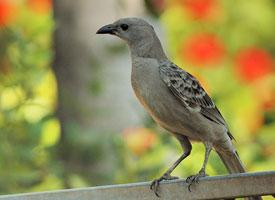
Greutăți și măsuri
| Lungime | de la 33 la 38 cm |
|---|
Descrierea animalului
The Great Bowerbird (Chlamydera nuchalis) is a remarkable species of bird that is native to Australia, primarily found across the northern parts of the continent. This species belongs to the Ptilonorhynchidae family, which is renowned for the males' unique behavior of constructing elaborate structures, known as bowers, as part of their courtship rituals. The Great Bowerbird is the largest of its kind within its family, showcasing a blend of subtle and striking physical features, intriguing behaviors, and an impressive ability to mimic sounds from its environment.Physically, the Great Bowerbird is a medium to large bird, with adult males typically reaching lengths of up to 40 centimeters. Both sexes display a predominantly greyish-brown plumage, which provides excellent camouflage against the arid and wooded habitats they prefer. However, males can be distinguished by their slightly brighter plumage and a lilac nuchal crest, which is visible during courtship displays. Their eyes are a striking pink, which contrasts vividly with their otherwise muted tones. Juveniles and females are similar in appearance but are generally duller, with juveniles lacking the distinctive nuchal crest.
One of the most fascinating aspects of the Great Bowerbird is its bower-building behavior. Males are known to construct elaborate structures from twigs, which are carefully arranged to form an avenue-shaped bower. Unlike nests, these bowers are not used for rearing young but are instead artistic creations used to attract females. The males meticulously decorate their bowers with an array of brightly colored objects they collect, such as stones, shells, and even man-made items like glass and plastic. The choice and arrangement of these decorations are critical, as females visit multiple bowers to judge the quality of the male's construction and presentation before selecting a mate.
The Great Bowerbird's diet is omnivorous, consisting of fruits, seeds, insects, and occasionally small vertebrates. This varied diet supports their lifestyle across a range of habitats, including savannah woodlands, mangroves, and areas of urban development where they have adapted surprisingly well.
Communication and mimicry are also notable aspects of the Great Bowerbird's behavior. Males produce a variety of sounds during courtship, which include mimicry of other bird species and even human-made noises. This vocal versatility is thought to play a role in attracting females and deterring rivals.
Conservation-wise, the Great Bowerbird is currently listed as of Least Concern by the IUCN, thanks to its wide distribution and stable population. However, like many species, it faces threats from habitat destruction and the alteration of its natural environment due to human activity.
In summary, the Great Bowerbird is a unique and fascinating bird, celebrated for its complex courtship rituals, architectural prowess in bower construction, and vocal mimicry. Its adaptability to different environments has allowed it to thrive in various habitats across northern Australia, making it a captivating subject of study for ornithologists and bird enthusiasts alike.
Animale similare
Fotografii noi cu animale
Top 10 animale
- Dolphin gull (Leucophaeus scoresbii)
- Diana monkey (Cercopithecus diana)
- Moustached guenon (Cercopithecus cephus)
- Greek tortoise (Testudo graeca)
- Stone loach (Barbatula barbatula)
- Galápagos tortoise (Geochelone nigra complex)
- Japanese macaque (Macaca fuscata)
- Russian tortoise (Testudo horsfieldii)
- Common flying dragon (Draco volans)
- Galápagos penguin (Spheniscus mendiculus)
